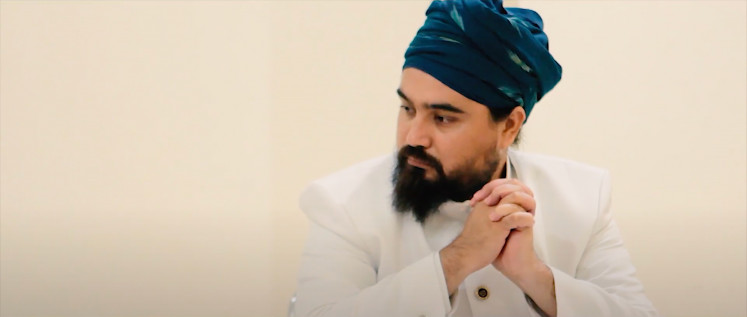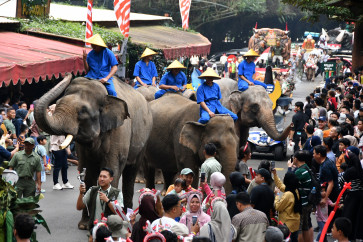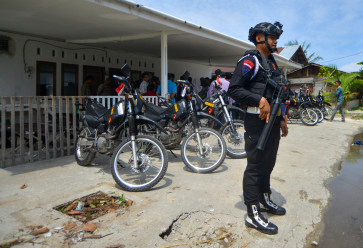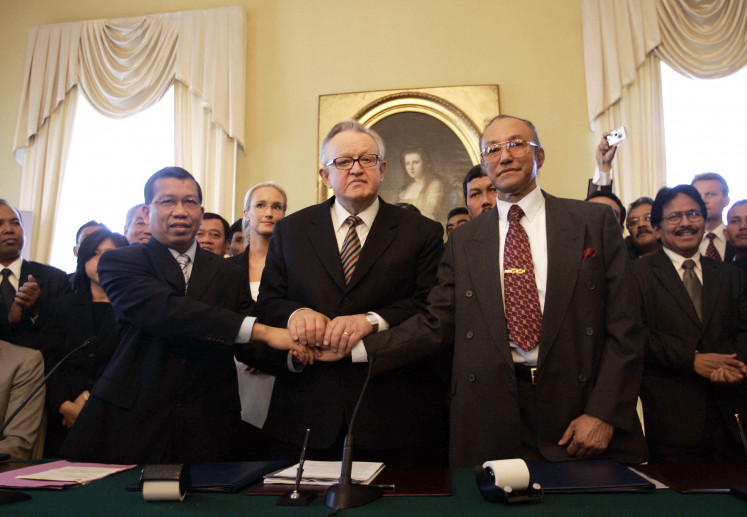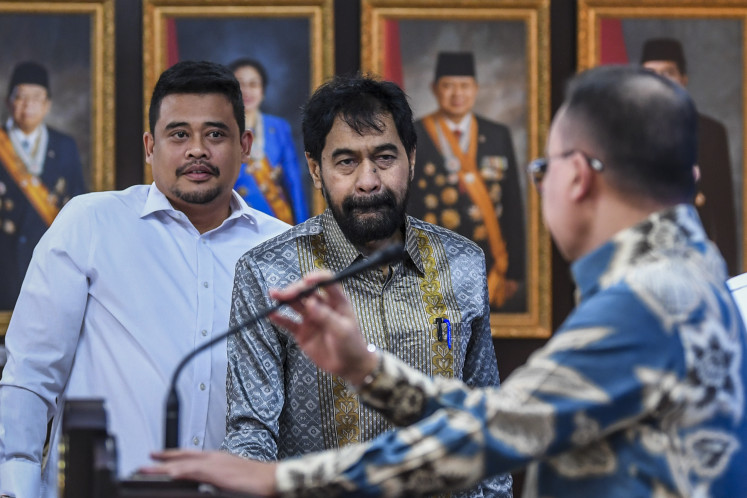Popular Reads
Top Results
Can't find what you're looking for?
View all search resultsPopular Reads
Top Results
Can't find what you're looking for?
View all search resultsPart I: Artist-activist Mumtaz Khan Chopan’s tale of fleeing Afghanistan for Indonesia
An Afghanistan-born Yogyakarta artist escaped from the death and destruction of his homeland before settling in Indonesia. Today, he uses art to free others like him from the consistent terror of marginalization.
Change text size
Gift Premium Articles
to Anyone
A
n Afghan-born Yogyakarta artist escaped from death and destruction of his homeland before settling in Indonesia. Today, he uses art to free others like him from the consistent terror of marginalization.
This is Part 1 of a two-part story. Part 2 will be published tomorrow.
A displaced child
One afternoon in 1996 Afghanistan, Mumtaz Khan Chopan – barely 6 years old – was walking back home from primary school, carrying his school notebook in his arms. “We will go to Pakistan,” Chopan recalled vague memories of what could be his mother’s or other relatives’ words upon his arrival in the house that day. The Taliban had taken over a third of their country.
“I remembered that there was war. [...] People were crying. One of the leaders of the Hazaras was killed,” said Chopan.
He remembered looking over from the roof of his house with his cousins during heavy snow in winter. They were observing the deceased leader’s body and cortège, all clad in black, marching through different villages and cities until the leader’s hometown. “It kind of looked like a black and white photograph.”
Chopan’s village had no electricity. His only means of information about the war was from a television nailed down on the back of a military jeep. He saw footage of the war that was shot in Kabul. Even as a child, he knew that something was wrong.
The same day he saw that footage, Chopan’s family left for Quetta, a city in Pakistan. He left behind the said notebook “on the corner, just behind the door,” the one detail that he recalled very clearly from his childhood in Afghanistan. Chopan’s relationship with his possessions is emotional; he finds solace and meaning behind his losses even later in life.
In Pakistan, Chopan’s family lived in a house with other refugees, in which he shared a 4 by 5-meter unpainted concrete room with 10 other people. As a child, he didn’t fully comprehend the difference as, although displaced, he was still living amongst his people.
“During the civil war in Afghanistan and when the Taliban took over, there were around 3 million Afghani refugees in Pakistan,” said Chopan.
In his primary school years, which were run by refugees and adhered to the curriculum of Afghanistan, Chopan’s interest in the arts started to pique as he got into sketching. He joined drawing classes after school in 2007, experimenting with ink, charcoal, pencil and crayons for three years until he graduated high school in Pakistan and moved back to Afghanistan in search of higher education. As a refugee, Chopan could not continue his studies in Pakistan.
He then went to Afghanistan for two months to take the national standardized exam, aiming for three art departments in Kabul and two other cities. Chopan listed the literature department as his fourth choice and he realized afterward that the passing grade was higher than his first.
“I just wanted to choose art,” he said. He was then accepted at Kabul University’s Faculty of Fine Art.
Wayfaring stranger: A still of Afghanistan-born Yogyakarta artist Mumtaz Khan Chopan in artist Elia Nurvista's work, titled “Safeguarding the Curry Burger”. Chopan played as a representative from India in the hypothetical debate regarding the genealogy of a curry burger. (Possibilities of Inauthentic Recipes 2/Elia Nurvista) (Possibilities of Inauthentic Recipes 2/Elia Nurvista)In pursuit of arts
As he arrived in Afghanistan to study art, Chopan was notified that he was accepted for a 4-year, fully-funded scholarship in Islamabad, Pakistan, to study computer science. He took the scholarship as it was “realistic, as some people were saying that you won’t be able to get a job studying art.”
He tried leading a dual study program for a while, trying out computer science studies during his art studies’ three-month winter break and testing whether or not he was still interested in computers.
Chopan was good with computers and found himself invited to teach at an institution in Pakistan as a 15-year-old.
“I knew a lot of things at that time. But no purpose.” He decided to follow with art and tried to change the scholarship for his studies in Kabul, which was rejected due to the limited quota for Afghanistan.
“Everyone in my art class [in Kabul] was surprised. ‘What the hell is wrong with you?’ they said. It was indeed quite a lot of money for us. They thought that I made a terrible mistake,” Chopan laughed. There wasn’t any tinge of regret in his tone.
As his conception of the arts slowly changed as he met many people and experienced various types of art through exhibitions and discussions, Chopan also felt that he was getting to know his country that he left when he was still a child.
“But I got bored quickly, because I thought they had nothing to teach. If it’s just a technique, I could learn it anywhere. [...] There were not many discussions about art, the meaning of art, what the artists should ultimately do and its purpose.”
He often entered into deep discussions during class with a particular Ukraine-educated painter who served as his department lecturer. “What is contemporary art? What is it that we are doing?” It yielded protests from his classmates, begging him to stop engaging the lecturer during class so that he could help the others paint. The more he learns about art, the more it gets fuzzier. “He said that contemporary art is not art? So what is art, then?”
Chopan used to arrive earlier than the others in the morning and would leave late at night, usually with two of his friends. He did a lot of experiments, discussions and even making videos, sleeping, at times, at the university’s studio and spending days on end drawing random things. “There was nothing else to do, nowhere else to go because my family was not there and I was alone.”
A year before he left Afghanistan, he participated in 2012 as a student in Documenta, a prominent quinquennial contemporary art exhibition held between Kassel, Germany, and Kabul, Afghanistan. Chopan could not comprehend the event’s significance back then.
Beings of value: Chopan's collaborative work with Ahmad Wali (left) and an untitled painting of his are exhibited at the National Gallery in Kabul, Afghanistan, in conjunction with Documenta 13, which was held in Kassel, Germany, in 2012. (Courtesy Mumtaz Khan Chopan) (Courtesy Mumtaz Khan Chopan/.)A human’s worth
“How can we suddenly have value?” Chopan reminisced. “People send you cars to come to the workshops. Normally, people don’t even look at us. They pay for our food and transportation. It was like living in a dream, in that naive age.”
Documenta 13 opened up a “wholly confusing world” for Chopan as he participated in workshops and an exhibition at the National Gallery’s garden in Kabul, where he stood side by side with respected contemporary artists of the world, oblivious of their fame.
“It changed things in me a little bit.” Having studied paintings in university, Chopan wondered why objects that seemed to have no “skilled work,” as put by Chopan, were so valuable and guarded by people, yet paintings were hard to come by in the exhibition.
“It also changed photography for me. I started exploring conceptual photography and experimented a lot,” said Chopan as he took another puff on his kretek cigarette. His gaze went downward as if shifting deep into his thoughts. His endeavor in photography often led him into dangerous situations with the Taliban.
Once, Chopan traveled from Kabul to take photos of his cousin’s wedding back in his village and his shuttle was stopped by the Taliban at a roadblock. Realizing that Chopan was carrying a camera, the passengers panicked and feared for their lives.
“Because at that time, [the Taliban] killed journalists and people working with the United Nations,” said Chopan. He dismantled his camera instantly and the women in the shuttle volunteered to hide it. “The Taliban never conducts searches on women.”
They were questioned under pressure. “One person was so afraid that he could not even speak.” Chopan, without his student identification card, said he was a tailor and claimed that the person was his apprentice.
In 2011, Chopan was taking photographs at an Ashura rally in Kabul when a suicide bomber detonated themself “very close” to him. “My clothes were full of blood,” said Chopan. Most of the blood, however, was not his.
He remembered the death toll was up to 110 back then. A similar experience also happened in 2005 in Pakistan, where Chopan went to the same rally (held yearly by Shi’a Muslims) with his cousins.
“I could see bullets hitting the floor.” The rally was attacked. His mother burned his bloodied shirt afterward. He had headaches for four straight days, seemingly a symptom of post-traumatic stress disorder.
Chopan ultimately feared for his life to the point of having a feeling that every car that passed him would explode.
“Art suddenly didn’t mean that much when life became absurd.” Combined with his loss of interest in the university, he thought he needed to leave in order to find and spare himself from the dangers.
Chopan then left for Indonesia.
Continued in part 2 tomorrow.


